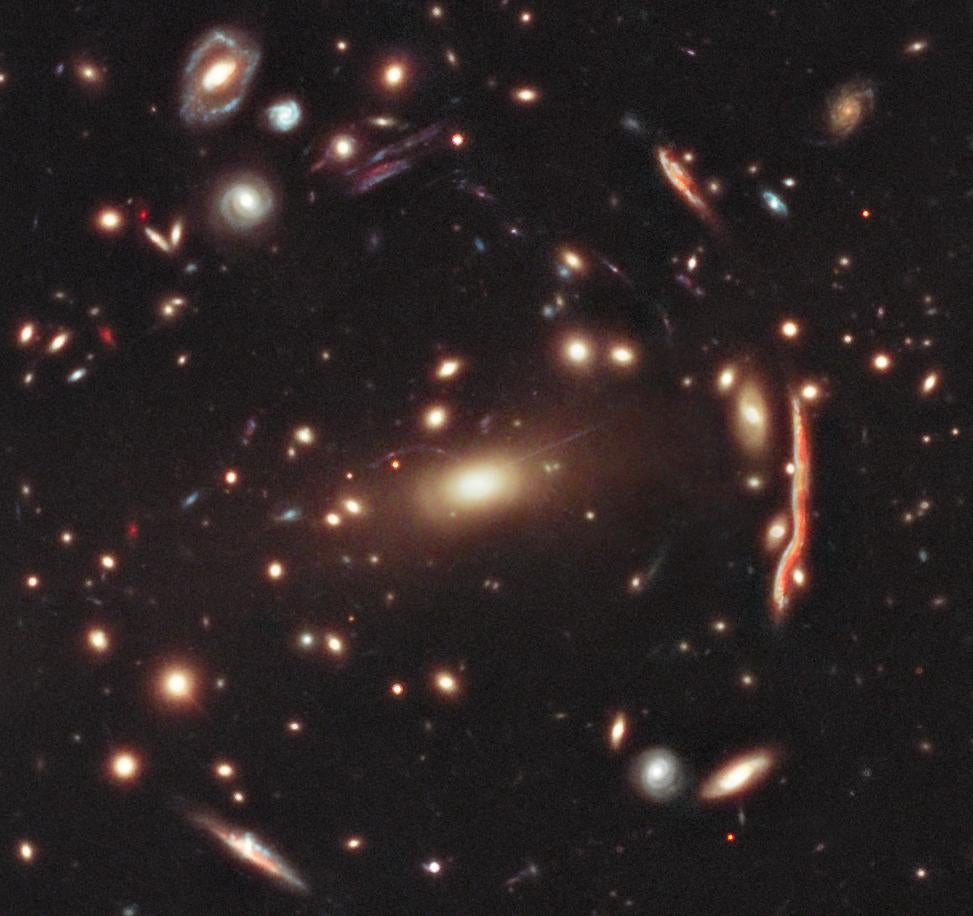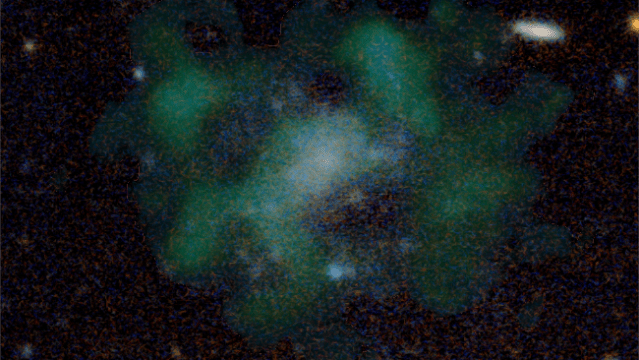Dark matter is the invisible something that gloms together galaxies like cosmic duct tape. But a team of researchers say they’ve found a distant galaxy entirely devoid of dark matter, a finding that could shake up understandings of both dark matter and galaxy formation.
Though we can’t directly observe dark matter (physicists believe it makes up about about 27% of the universe) we see the effects of its gravity. When looking out into the cosmos, we see that all galaxies seem to have “extra” mass — they behave as though they contain a lot more matter than the stuff we can actually detect. In the recent case, though, a team of astrophysicists tried to observe dark matter’s effects on the gas rotating within a distant dwarf galaxy, but they found that normal matter alone could explain the gas’s movement. There was no place for dark matter, as far as they could tell. The team’s research has been accepted for publication in the Monthly Notices of the Royal Astronomical Society.
Filippo Fraternali, an astrophysicist at the University of Groningen in the Netherlands and a co-author of the paper, told Gizmodo in an email that the galaxy the team studied could be held together only by its visible mass — which sounds perfectly reasonable, except that dark matter is believed to be a major ingredient in all galaxies. “The main problem is that, in our scenario of galaxy formation, galaxies cannot form without dark matter, and even more so, dwarf galaxies should have large amounts of it,” Fraternali said. “There is therefore something that we do not understand.”
The galaxy is named AGC 114905 and is roughly 250 million light-years from Earth. It’s ultra-diffuse, meaning its matter is spread across a vast amount of space; AGC 114905 is about the size of the Milky Way but has about 1,000 times fewer stars. The research team used the National Radio Astronomy Observatory’s Very Large Array Telescope to look at the rotation of gas in the galaxy over 40 hours, spanning from July through October 2020.

The findings are similar to that on NGC1052-DF2, a different dwarf galaxy seemingly to lack dark matter that was described in 2018. Pretty quickly, a controversy erupted over the claim; some astrophysicists thought the galaxy was evidence of a new type of galactic growth, while others thought it was being misinterpreted and that the team needed more data. That a galaxy could simply have no dark matter was a fairly shocking claim.
Recently, a team double-checked the measurements on NGC1052-DF2, which seemed to affirm what the original team had found regarding the galaxy’s distance, and thus, its dark matter content. Nicolas Martin, an astronomer at the Max Planck Institute for Astronomy, told Gizmodo at the time that the galaxy “may have had an unexpected formation and evolution” and “the good thing is that upcoming telescopes and surveys should make it easier to both understand NGC1052-DF2 and to place meaningful constraints on how peculiar it is. In other words, is this system exceedingly rare or is it part of a bigger population that are currently not explained easily by galaxy formation models?” Now, with the discovery of AGC 114905, there’s more evidence that there’s indeed a population galaxies that just can’t be explained by current models.
The recent team found that the AGC 114905’s dark matter halo — the footprint of dark matter in and around a galaxy — would have to be made up of practically (if not entirely) no dark matter in order to match the data they collected. One explanation for the absence was that the galaxy had been stripped of its dark matter by large galaxies nearby — except there were no such galaxies around it.
“Theory predicts that there must be dark matter in AGC 114905, but our observations say there isn’t,” said Pavel Mancera Piña, an astrophysicist at the University of Groningen in the Netherlands and lead author of the paper, in a Royal Astronomical Society press release. “In fact, the difference between theory and observation is only getting bigger.”
Another theory was that the angle at which the team observed the galaxy made the dark matter hard to see, but co-author Tom Oosterloo, an astrophysicist at the Netherlands Institute for Radio Astronomy, noted in the same release that the actual angle would be pretty extreme as compared to the team’s estimate.
Currently, the team is investigating a second ultra-diffuse galaxy, to see if it too is improbably lacking in the dark matter department. If it is, it’ll buttress the team’s analysis of the first galaxy. Observations are now underway, and Fraternali said the team expects similar data. The more we learn about it, the more enigmatic dark matter seems to become.
More: What Is Dark Matter and Why Hasn’t Anyone Found It Yet?
